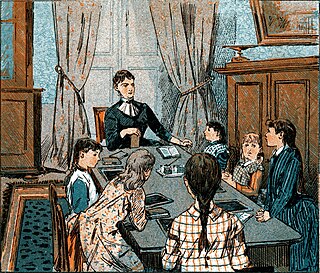Related Research Articles

Homeschooling or home schooling, also known as home education or elective home education (EHE), is the education of school-aged children at home or a variety of places other than a school. Usually conducted by a parent, tutor, or online teacher, many homeschool families use less formal, more personalized and individualized methods of learning that are not always found in schools. The actual practice of homeschooling varies considerably. The spectrum ranges from highly structured forms based on traditional school lessons to more open, free forms such as unschooling, which is a lesson- and curriculum-free implementation of homeschooling. Some families who initially attended a school go through a deschool phase to break away from school habits and prepare for homeschooling. While "homeschooling" is the term commonly used in North America, "home education" is primarily used in Europe and many Commonwealth countries. Homeschooling should not be confused with distance education, which generally refers to the arrangement where the student is educated by and conforms to the requirements of an online school, rather than being educated independently and unrestrictedly by their parents or by themselves.

A primary school, elementary school, or grade school is a school for primary education of children who are 4 to 10 years of age. Primary schooling follows preschool and precedes secondary schooling.

Apprenticeship is a system for training a new generation of practitioners of a trade or profession with on-the-job training and often some accompanying study. Apprenticeships can also enable practitioners to gain a license to practice in a regulated occupation. Most of their training is done while working for an employer who helps the apprentices learn their trade or profession, in exchange for their continued labor for an agreed period after they have achieved measurable competencies.

Education in England is overseen by the Department for Education. Local government authorities are responsible for implementing policy for public education and state-funded schools at a local level. State-funded schools may be selective grammar schools or non-selective comprehensive schools. All state schools are subject to assessment and inspection by the government department Ofsted. England also has private schools and home education; legally, parents may choose to educate their children by any suitable means.
Truancy is any intentional, unjustified, unauthorized, or illegal absence from compulsory education. It is a deliberate absence by a student's own free will and usually does not refer to legitimate excused absences, such as ones related to medical conditions. Truancy is usually explicitly defined in the school's handbook of policies and procedures. Attending school but not going to class is called internal truancy. Some children whose parents claim to homeschool have also been found truant in the United States.
Education in the United Kingdom is a devolved matter with each of the countries of the United Kingdom having separate systems under separate governments. The UK Government is responsible for England, whilst the Scottish Government, the Welsh Government and the Northern Ireland Executive are responsible for Scotland, Wales and Northern Ireland, respectively.

A state school, public school, or government school is a primary or secondary school that educates all students without charge. Such schools are funded in whole or in part by taxation and operated by the government of the state.
Education in the Republic of Ireland is a primary, secondary and higher education. In recent years, further education has grown immensely, with 51% of working age adults having completed higher education by 2020. Growth in the economy since the 1960s has driven much of the change in the education system. For universities there are student service fees, which students are required to pay on registration, to cover examinations, insurance and registration costs.

Twelfth grade is the twelfth year of formal or compulsory education. It is typically the final year of secondary school and K–12 in most parts of the world. Students in twelfth grade are usually 17–18 years old. Some countries have a thirteenth grade, while other countries do not have a 12th grade/year at all.

Compulsory education refers to a period of education that is required of all people and is imposed by the government. This education may take place at a registered school or at other places.
Year 12 is an educational year group in schools in many countries including England, Wales, Northern Ireland, Australia and New Zealand. It is sometimes the twelfth year of compulsory education, or alternatively a year of post-compulsory education. It usually incorporates students aged between 16 and 18, depending on the locality. It is also known as "senior year" in parts of Australia, where it is the final year of compulsory education. Year Twelve in England and Wales, and in New Zealand, is the equivalent of Eleventh grade, junior year, or grade 11 in the US and parts of Canada.
Educational stages are subdivisions of formal learning, typically covering early childhood education, primary education, secondary education and tertiary education. The United Nations Educational, Scientific and Cultural Organization (UNESCO) recognizes nine levels of education in its International Standard Classification of Education (ISCED) system. UNESCO's International Bureau of Education maintains a database of country-specific education systems and their stages. Some countries divide levels of study into grades or forms for school children in the same year.
Queensland state schools are government-funded primary schools throughout Queensland, Australia that provide universal free education from Prep to Year 6. Queensland state schools are funded by the Department of Education. In some rural communities, state schools can provide education up to year 10, roughly until students are 16 years old.
The raising of school leaving age is the term used by the United Kingdom government for changes of the age at which a child is allowed to leave compulsory education in England and Wales as specified under an Education Act.
Year 11 is an educational year group in schools in many countries including England and Wales, Northern Ireland, Australia and New Zealand. It is the eleventh year of core education. For some Year 11 students it is their final year studying and may include final exams. In the US and Canada, it is referred to as tenth grade. Students in Year 11 are usually aged 15 to 16.
The school leaving age is the minimum age a person is legally allowed to cease attendance at an institute of compulsory secondary education. Most countries have their school leaving age set the same as their minimum full-time employment age, thus allowing smooth transition from education into employment, whilst a few have it set just below the age at which a person is allowed to be employed.
The history of education in England is documented from Saxon settlement of England, and the setting up of the first cathedral schools in 597 and 604.

Education in Malta is compulsory through age sixteen and is offered through three different providers: the state, the church, and the private sector. The state is responsible for promoting education and instruction and ensuring universal access to education for all Maltese citizens the existence of a system of schools and institutions accessible to all Maltese citizens. The objectives of education in Malta include intellectual and moral development and the preparation of every citizen to contribute productively to the national economy. Although Maltese citizens had access to education during the Arab administration of 870 to 1090, the arrival of a number of religious orders in the following four centuries brought religious-based education to the island for wealthy families. The arrival of the Knights Hospitaller saw the establishment of the University of Malta, around which a number of primary, secondary and post-secondary institutions were established. Education in Malta has been universally available at the primary level since the ejection of the Knights Hospitaller by the French in 1798, when state-funded elementary schooling was established. In 1878, English replaced Italian as the primary language of instruction, and education was made compulsory in 1946 in response to a number of children not attending school due to poverty between World Wars One and Two. The age at which education became compulsory was lowered to five years in 1988

Homeschooling is illegal in many countries. Countries with the most prevalent homeschooling movements include Australia, Canada, New Zealand, the United Kingdom, and the United States. Some countries have highly regulated homeschooling programs as an extension of the compulsory school system; few others, such as Germany, have outlawed it entirely. In some other countries, while not restricted by law, homeschooling is not socially acceptable, or is considered undesirable, and is virtually non-existent.
References
- ↑ "Upper Compulsory School Age". National Conference of State Legislators. 21 January 2014. Retrieved 3 May 2015.
- ↑ "State Education Practices (SEP)".
- 1 2 Knesset raises school dropout age to 18 Haaretz, 18 July 2007 Archived February 12, 2009, at the Wayback Machine
- 1 2 3 4 School: leaving it too early Online Opinion, 1 September 2005 Archived January 3, 2014, at the Wayback Machine
- ↑ Contribution to EIRO thematic feature on Youth and work - case of France Archived 2012-08-02 at archive.today EIRO, 5 March 2007
- 1 2 3 4 5 Fahey, Tony (July 1992). "State, family and compulsory schooling in Ireland". Economic & Social Review. 23 (4). Economic & Social Research Institute: 369–395. hdl:2262/66539. ISSN 0012-9984. Archived from the original on 2014-01-06.
- ↑ "Report of the Royal Commission of inquiry into primary education". 1870. Archived from the original on 2014-01-06. Retrieved 6 January 2014.
- ↑ "Report of the Vice-Regal Committee of Enquiry into Primary Education (Ireland) 1918; volume I: report". 1919. Archived from the original on 2014-01-06. Retrieved 6 January 2014.
- ↑ "School Attendance Act, 1926, Section 4". Irish Statute Book . Archived from the original on 2014-01-07. Retrieved 6 January 2014.
- ↑ "Legislation Directory: 1926 acts affected". Irish Statute Book . pp. 17: School Attendance Act, 1926. Archived from the original on 2014-01-07. Retrieved 6 January 2014.
- ↑ "School Attendance Act, 1936, Section 2". Irish Statute Book . Archived from the original on 2014-01-07. Retrieved 6 January 2014.
- ↑ Hyland, Áine; Milne, Kenneth (1992). Irish Educational Documents. NAIRTL. pp. 47–48. ISBN 978-0-9509289-2-0 . Retrieved 6 January 2014.
- ↑ "S.I. No. 105/1972 - School Attendance Act, 1926 (Extension of Application) Order, 1972". Irish Statute Book . Archived from the original on 2014-01-07. Retrieved 6 January 2014.
- ↑ "School attendance". Citizens Information. Ireland: Citizens Information Board. 2 January 2014. Archived from the original on 2014-01-06. Retrieved 6 January 2014.
- ↑ "Education (Welfare) Act, 2000". Irish Statute Book . §§2, 17. Archived from the original on 2013-10-23. Retrieved 6 January 2014.
- ↑ "Education (Welfare) Bill, 1999: Second Stage". Seanad Éireann debates. 19 May 1999. pp. Vol.159 No.10 p.8 c.757. Archived from the original on 2014-01-06. Retrieved 6 January 2014.
The Bill, when enacted, will raise the school leaving age from 15 years to 16 years or the completion of three years' post-primary education, whichever is the later.
- ↑ Title of good practice: Basic skills for minor apprentices European Civil Society Archived September 30, 2007, at the Wayback Machine
- ↑ An Overview of the Education System in Poland - SQA Archived April 5, 2008, at the Wayback Machine
- ↑ Spain RightToEducation.org, 12 November 2001 Archived July 3, 2008, at the Wayback Machine
- ↑ "Rebel pupils 'moving to violence and delinquency'". The Glasgow Herald. 8 October 1973. p. 3. Retrieved 8 August 2021.
- ↑ "An Evening Times Special Inquiry: The Reluctant Year". Evening Times. 27 August 1974. p. 3. Retrieved 8 August 2021.
- ↑ "The reluctant learners of 15 and above who are jeopardising the secondary school system". Evening Times. 28 August 1974. p. 3. Retrieved 8 August 2021.
- ↑ "School is 'wasted' for many". Evening Times. 4 October 1974. p. 7. Retrieved 8 August 2021.
- ↑ BBC - Schools Parents - What happens after the age of 16? Archived January 2, 2013, at the Wayback Machine
- ↑ Under-18s who leave school to be fined The Independent, 23 March 2007
- ↑ NSW Govt considers raising school leaving age ABC News, 17 November 2006 Archived October 7, 2008, at the Wayback Machine
- 1 2 "School leaving age". NSW Government. June 5, 2023.
- ↑ MP moots change to school-leaving age ABC News, 10 March 2006 Archived October 7, 2008, at the Wayback Machine
- ↑ "New school leaving age for South Australia". Premier Mike Rann. 2007-05-02. Archived from the original on 2011-07-06. Retrieved 2010-01-06.
- ↑ http://www.education.tas.gov.au/school/educators/guaranteeing-futures/requiringparticipation Department of Education Guaranteeing Futures legislation 16 July 2008 Archived October 7, 2008, at the Wayback Machine
- 1 2 "4.5 Pathways for leaving school" (PDF). The State of Western Australia's Children and Young People - Edition Two: 188.
- 1 2 "If your child wants to leave school early". Victorian Government. January 31, 2023. Retrieved December 21, 2023.
- ↑ "Stages of schooling". Northern Territory Government.
- 1 2 "Attendance". ACT Government. Retrieved December 21, 2023.
- ↑ "Age to leave school". Youth Law Australia. Retrieved December 21, 2023.
- ↑ "Schools". Legal Aid Queensland. Retrieved December 21, 2023.
- ↑ "School Leaving Age". Archived from the original on 2016-08-08. Retrieved 2016-06-07.
- ↑ "Age to leave school". Youth Law Australia. Retrieved December 21, 2023.
- ↑ "Primary and intermediate schooling in NZ". Ministry of Education. September 7, 2023.